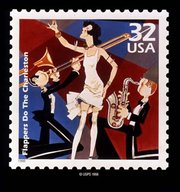Charleston (dance)
|
|
The Charleston is a dance, named for the city of Charleston, South Carolina. It was popular in the 1920s, and spawned Lindy Hop in the 1930s. Charleston is danced in 8-count: solo, with a partner, or in groups (usually facing lines).
The rhythm is a traditional one from West Africa; it was popularized in mainstream dance music in the United States of America by a 1923 tune called The Charleston by composer/pianist James P. Johnson which originated in the Broadway show Runnin' Wild and became one of the most popular hits of the decade.
| Contents |
Solo
When dancing solo or in groups, the hands are often swung forward and back, opposite the direction of the corresponding foot. Often the fingers are held together pointing sideways away from the body, leaving the palms parallel to the floor.
Charleston can be danced solo, its simple, flexible basic step making it easy to concentrate on style and musicality.
The default is to dance a basic step. One person will typically then call out a variation (such as turning 360 degrees in place on counts 5-8), which is then done by everyone beginning the next measure and again for the following 2 measures. If the caller doesn't call another step immediately, the dancers return to the basic step. Switching sides is sometimes called, upon which the dancers hop on the left foot across to the other side on counts 5-8, turning 180 degrees to the left.
Couples
The basic step depends on the style of Charleston one wants to perform. Charleston had a few stylistic changes throught the 1920s-1940s, and the basic step and holds would change through the different musical eras.
20s Charleston: The man and the lady stand facing each other. The man's right hand should be placed on the lady's back, between her shoulder blades. The lady's left hand should rest on the man's arm or shoulder; this amplifies their connection. The man's left hand and the lady's right hand are clasped palm to palm, slightly resembling a ballroom dance connection. The basic step is for the man to touch his left foot behind him, but not to shift his weight on counts 1 and 2, while the lady mirrors the motion by touching her right foot in front of her without shifting weight. On counts 3 and 4, both the man and the lady bring their feet back to a standing position, but shift their weight onto the foot they just moved. On counts 5 and 6, the man touches his right foot in front of himself while the lady touches her left foot back. On 7 and 8, both feet are brought back to the standing position where the necessary weight shift occurs to allow the basic step to repeat.
40s Charleston: The basic hold is for the lady to stand next to the man on the man's right side. The man holds the lady's right hand with his left. The man's right hand is placed on the lady's waist on her right side; thus he can lead her right side with his hand, in conjunction with his forearm across her lower back. The lady's left hand is placed on the man's right shoulder.
To lead the basic step, then, the man uses his right hand to lead the lady's right side (and thus foot) back as he steps back on his left foot. He then leads her right side forward as he kicks and steps forward on counts 3 and 4. Likewise, the mirror-image lead continues for the second half of the step.
Groups
A common formation for dancing in groups is to form two long lines of dancers facing each other. Each dancer should have arms' width of space to himself laterally and the lines should be around 6 feet apart.
See Also
The descriptions of the steps of Charlestion are moved to Charleston (dance move). Note also that Lindy Hop uses this steps, as part of the dance.

